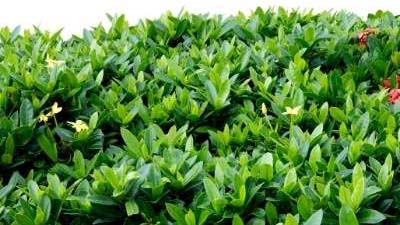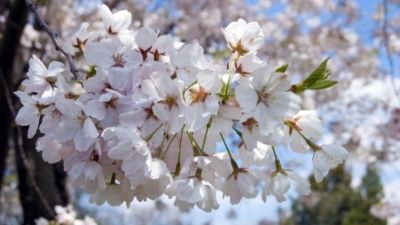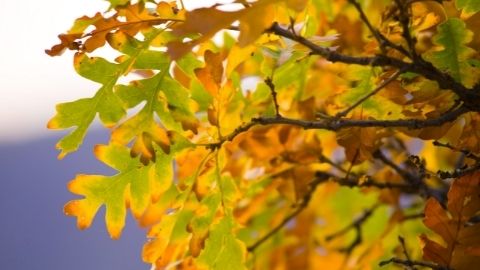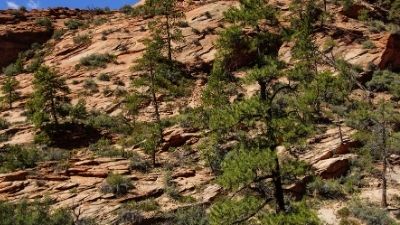Gambel Oak in the Landscape
Introduction
Gambel oak (Quercus gambelii Nutt.), commonly called scrub oak, Rocky Mountain white oak, or Utah white oak, is native to the western part of the U.S., including Colorado, Utah, New Mexico, Wyoming, and Arizona. It is usually distributed in dry slopes and canyons at an elevation of 3000–8000 feet. It can grow well in the USDA hardiness zones between 3 and 9 and is well adapted to the Wasatch Front (zone 5). Gambel oak grows as a shrub or a small tree with an average height of 20–30 feet and a width of 15 feet. Leaves are about 5 inches long with several rounded, deeply cut lobes on each side of the central vein. Twigs are brownish in color, usually crooked and distorted. Branches typically are ascending, forming an irregular crown. The fruit is a typical acorn, about ¾ of an inch long and half enclosed with a cup (Figure 1). The bark is red-brown to gray with rough furrows on older stems. Rigid and heavy, Gamble oak wood is sometimes used for firewood.

That Distinguish Oak Trees
Usability in the Landscape
Gambel oaks are small, informal, deciduous trees that are sometimes used for mass planting. It can be grown to screen parking lots and undesirable views. Due to its small size, robust nature, low water requirement, and fewer pests problems, it fits well on residential lots, conservation parks, and below or close to electrical lines but may not be a good choice for a single specimen tree or a street tree.
Leaves emerge late in the spring, allowing open sunlight conditions for spring flowers nearby the tree. The leaves are dark green in the summer, turn yellow or reddish-brown in late fall and then drop from the trees. It can be planted or maintained in natural or wildland-type areas of the landscape.
Gambel oak is a long-lived and robust plant, making it an effective planting as a windbreak. Having Gambel oak on the property generally adds an aesthetic and monetary value to the property. Oak provides valuable food and cover to wildlife such as deer, birds, and squirrels. It is also a great choice for watershed protection. All parts of Gambel oak tree contain gallotannins which may be toxic to herbivores such as cattle, sheep, and horses. More than 75% of an animal diet comprised of Gambel oak may be fatal. Young leaves and acorns are more toxic compared to old and mature leaves.
Gambel oak leaves can be used as garden mulch to regulate soil temperature, lower weeds, improve soilwater retention, and add nutrients to the soil. However, leaves from Gambel oak degrade very slowly, so shred them before using as a mulch.
It is a common misbelief that oak leaves increase soil acidity. Although Gambel oak leaves have lower pH, once degraded, they become neutral and do not fluctuate soil pH.
Growth Requirements
Gambel oak requires full sun and is well adapted to rocky sites and alkaline soils. Once established, Gambel oak is drought tolerant and does not require irrigation. It grows well in sunny locations and harsh growing conditions. Continuous shade can reduce its growth.
Fertilizing
Gambel oak is a slow-growing plant and no research evidence exists of better plant health with fertilization under normal conditions, but if desired, increase the growth rate by applying fertilizers at one-half the recommended rate (N:P2O5:K2O—16:4:8 or 12:4:8), followed by frequent irrigation (2–3 times a week depending on soil moisture).
Apply 1 pound of nitrogen to 1000 square feet of the root zone; double the application rate if symptoms of nitrogen deficiency are visible in plant leaves. When applying fertilizers, apply fertilizer granules to the soil surface above the root zone or below mulch and promptly irrigate after fertilizer application. Slow-release fertilizer can supply nutrients to the plants for more extended periods (usually three to six months) and has lesser environmental consequences, hence it is preferred.
Irrigating
Irrigation during the establishment phase and unusually dry season is recommended. Gambel oak roots usually reach 15–20 inches below the ground. Therefore, use a drip irrigation system to saturate the soil to the depth of 10–15 inches every three to four weeks or as required. Irrigate in the morning to reduce plant stress and increase irrigation efficiency. Healthy plants do not require irrigation during average rainfall seasons.
Propagation
Gambel oak rarely reproduces by acorns but instead spreads by underground stems called lignotubers orrhizomes, forming dense and continuous vegetation. Native Gambel oaks transplant poorly. In a Gambel oak research study conducted by Larry Rupp, Ph.D., selecting older stock (stem) and application of auxin increased the success rate for Gambel oak mound layering propagation. However, only 13 to 21% of layering was successful. Therefore, containerized plugs sold by retail nurseries can be used to achieve a higher survival rate and proper establishment of Gambel oak.
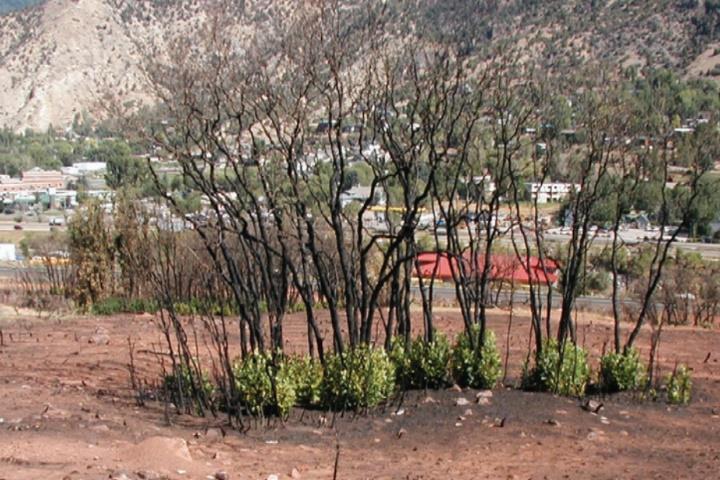
Photo from Colorado State University Extension fact
sheet 6.311, reprinted with permission.
Fire Hazard
While Gambel oak has many benefits, growing Gambel oak in landscapes may also increase the risk of fire hazards. Dense stands of these trees and horizontal continuity will accumulate large amounts of fuel, leading to risky fire situations. Fire hazards are higher during droughts and more likely to occur during late summer or fall when the leaves are dry. Gambel oaks are adapted to moderate fire and grow back quickly (sometimes in the same season) from lignotubers and rhizomes after the fire events (Figure 2). However, mitigating the fire hazards in Gambel oak vegetation is a wise decision. Minimize fire risk by thinning plants and breaking up the continuity. Annually prune or mow new emerging sprouts and cut back dead, damaged, and deformed branches. Cut and remove the top quarter of plants and heavily thin the plant canopy at 12–15 feet interval. Gambel oak is a robust plant and comes back quickly even after heavy pruning or other kinds of stress; therefore, application of contact herbicide at pruned or mowed sites may sometimes be necessary. It is best to prune plants during late fall or early spring.
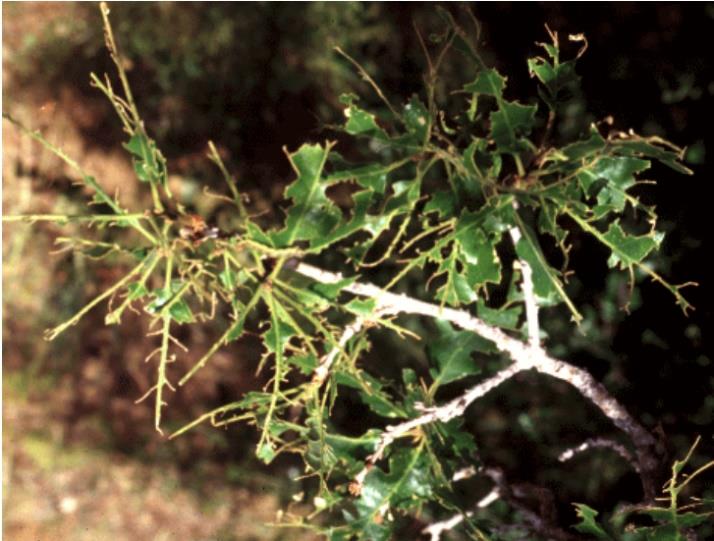
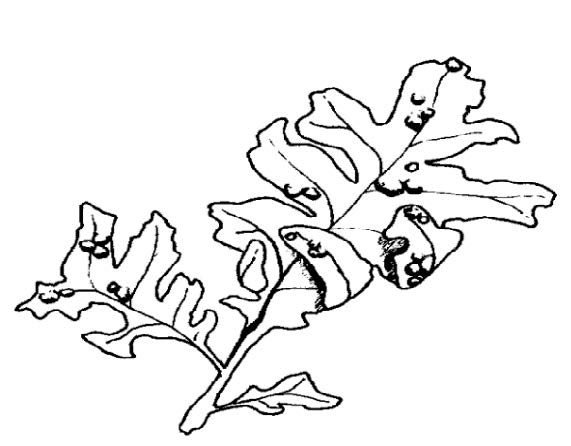
Drawing by Valori Herrmann.
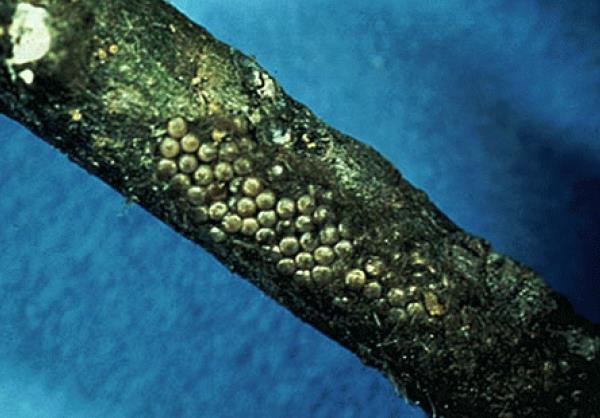
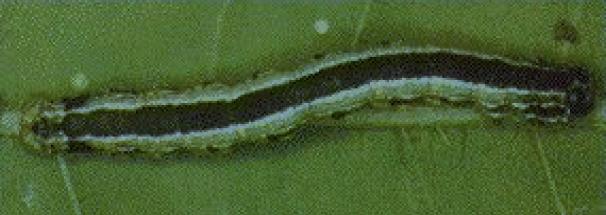
Photos by John H. Ghent, USDA Forest Service, Asheville,
NC. Used with permission.
Diseases and Pests
Gambel oak is a hearty and resistant plant with very few diseases and pests problems. Therefore, routine pest control is unnecessary. The pest control recommendations given below are intended for serious pest outbreaks that threaten valuable landscape plants (Figure 3). Refer to the Pacific Northwest Insect and Disease Management Handbooks (http://uspest.org) or similar locally adapted references for pesticide recommendations. Always read and follow label directions. Some insect pests affecting Gamble oak include:
- Galls appear as round, swollen areas on stems and leaves and are quite common on oak (Figure 4). Most galls are caused by small flies or wasps. One control method is collecting and disposing of leaves after they have fallen to the ground. On small trees, it may be possible to remove galls by pruning before wasps emerge. Control is not usually justified, but in cases of severe damage, one recommendation is applying an insecticide as leaves unfold in spring.
- Leaf galls are formed by many species of cynipid wasps. These galls appear as small spots, bumps, or round balls on leaves and start green in color and then turn brown. They are not a serious problem.
- Stem galls appear as a swollen, woody a reason small stems and vary in size from peasize to ½ inch in diameter. Most galls are harmless, but some stem galls weaken twigs and cause dieback.
- Leafrollers and cankerworms are common foliage feeders on oak. Both insects can be controlled by applying dormant oil plus an insecticide in early spring before leaves emerge. This controls insects that have over wintered on the tree. Another good control for these caterpillars are biological insecticides such as those containing BT(Bacillus thuringiensis).
- Leafrollers roll up leaves with webbing and then feed inside the rolled leaves. The larval stage of this insect is a ¾ inch long green caterpillar with a black head. Leafrollers over winter as eggs on twigs and hatch in spring soon after leaves emerge. High infestation levels occur on a cyclical basis every few years. Trees can withstand the loss of one third of the foliage without adverse effects. However, to control leafrollers, it is best to spray right after eggs hatch and before larvae form the protective webbing.
- Cankerworms include both fall and spring species of cankerworms, based on when eggs are laid. Both species hatch out in the spring. Larvae are slender, green-striped, looping caterpillars (Figures 4 and 5). They hang from trees by silken threads and can cause serious defoliation in some years. Adult male moths are gray to light brown in color and have a wingspan of about 1 inch. Moths can appear in great numbers and invade homes and buildings in late fall. Female moths are about ½ inch long and wingless.
- Cicadas are large winged insects that produce a clicking noise. They can appear in great numbers for four to six weeks in June and July. They do not feed on leaves but can cause damage from egg-laying wounds to the bark. The injury results in deep gouges that weaken small twigs, causing them to break in the wind. There are several cicada species in Utah but the famous “17-year locust” is not present.
Many disease problems result from abnormal rainfall or overwatering. To control, reduce irrigations or move sprinkler heads away from trees. Some of the common diseases include:
- Anthracnose is a fungus that frequently develops during wet spring weather. It causes scattered brown spots on leaves, commonly along veins. Severely affected leaves may curl, pucker, or twist down. This fungus may also attack twigs, causing cankers and twig dieback. Raking up and disposing of fallen leaves offers some control. Prune out and destroy diseased and dead branches. If prolonged wet weather occurs during budbreak and early shoot growth, treat with a fungicide labeled for oak.
- Perennial canker is an occasional problem caused by a fungus that forms cankers on weak and dying wood. Avoid injury to the tree. Prune out any infected twigs.
- Leaf blister is a fungus that causes raised yellowish-white spots on the upper leaf surface and is common in wet springs. The leaves remain attached to the tree. Cultural control includes applying fertilizer to increase tree vigor and raking up leaves. Usually, chemical control is unnecessary.
- Powdery mildew is a powdery white fungal growth on the surface of leaves. Later in the season, small black fruiting bodies of the fungus may be present on the leaves. This disease is very common and visually unappealing but does not usually cause damage to the tree. Control with a fungicide applied when leaves begin to emerge.
- Root rot is a fungus that attacks and destroys roots. This problem is often caused by overwatering or broken sprinkler heads. Root rot also commonly occurs when irrigating natural stands of oak.
- Heart rot is a fungus that rots out the interior of the tree. This disease usually occurs on older trees when fungus enters through pruning cuts and wounds.
- Lichens are a symbiotic relationship between fungi and algae which cause green or orange colored patches on the bark of oak. They do not harm the tree.
Care and Maintenance
Although Gambel oak has a vigorous shoot system, any damage to the root may threaten the plants. Construction work such as digging and excavation near Gambel oak vegetation can injure its rooting system, causing Gambel oak to decline and die. Often all plants in an area are interconnected, so damage to one plant may affect other plants that are several feet away. Therefore, care should be taken when working close to Gambel oak vegetation.
A healthy and mature oak plant is tolerant to drought, but irrigation is recommended during the establishment and propagation phase and should continue until the plants are well-rooted.
References
- Cranshaw, W., Leatherman, D., & Kondratieff, B. (1994). Insects that feed on Colorado trees and shrubs. Colorado State University Extension. https://static.colostate.edu/client-files/csfs/pdfs/steamboatdistrict/Insects_Feed_Trees.pdf
- Jester, N., Rogers, K., Dennis, F. C. (2012). Gambel oak management [Fact sheet 6.311]. Natural Resources Series, Colorado State University Extension.
- Johnson, C. M. (1984). Native trees of the Intermountain Region. Utah State University Extension.
- Kaufmann, M. R., Huisjen, D. W., Kitchen, S., Babler, M., Abella, S. R., Gardiner, T. S., Mcavoy, D., Howie, J., & Page, D. H. (2016). Gambel oak ecology and management in the Southern Rockies: The status of ourknowledge. Southern Rockies Fire Science Network, Colorado State University.
- McPherson, E. G., & Graves, G. H. (1984). Ornamental and shade trees for Utah. Utah State University Extension.
- Rupp, L. A. (2017). Propagation of Gambel oak (Quercus gambelii) by layering. Acta Horticulturae 1174(35),173–174. DOI: 10.17660/ActaHortic.2017.1174.35 https://doi.org/10.17660/ActaHortic.2017.1174.35
Photos are by authors unless otherwise specified.
Authors
Shawn Olsen and Debbie Amundsen; Revised September 2021 by Shital Poudyal
Related Research



